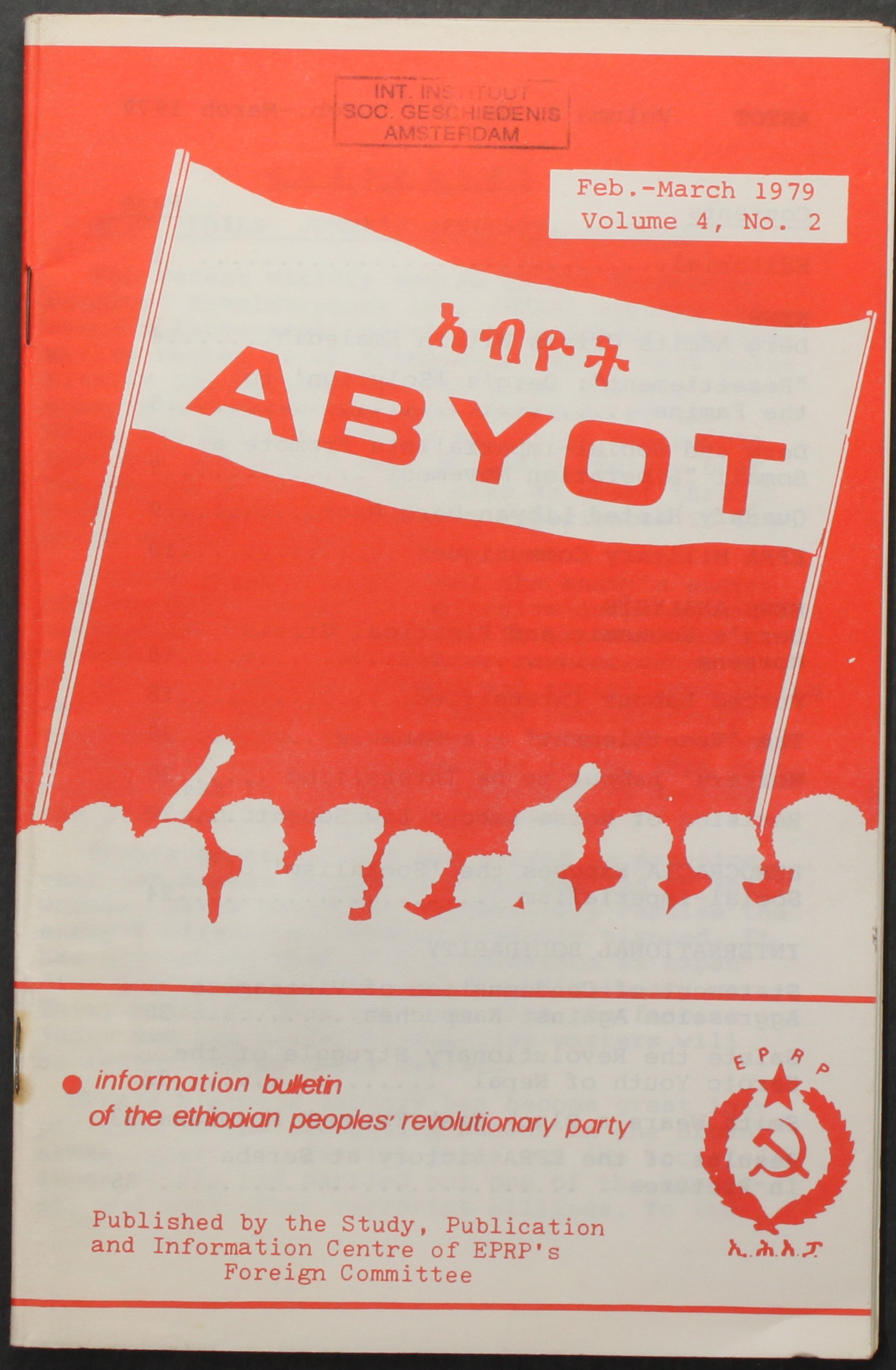
The origins of the Ethiopian communist movement were in the radical student movement in the 1960s. While Italian communists are known to have participated in the resistance against the Italian fascist occupation of Ethiopia in 1936–1941, there was no tradition of communist organizing in Ethiopia’s tiny developing working class or nascent peasant movement. Starting with the Crocodile Society in Addis Ababa in 1965, Ethiopian student radicals began to formulate demands like “Land to the Tiller!” to challenge the stifling rule of Emperor Haile Selassie and his feudal aristocracy.
Exposed to the new left in the universities of Europe and North America, a generation of Ethiopian young people looked to the struggles of Cuba, the guerrilla campaigns of Che Guevara, to Mao and peasant China, to the Black Panther Party, and especially to Ho Chi Minh and the Vietnamese people for guidance and inspiration. Finding itself within what might broadly be termed the anti-revisionist milieu, the Ethiopian student movement studied Marx, Lenin, and Mao, as well as figures like Fanon and Vo Nguyen Giap.
By the early 1970s, confronting massive repression at home, the student movement looked to transform itself into a revolutionary movement and began to build toward initiating armed struggle and to establishing a Marxist-Leninist party. Several distinct currents emerged, largely clandestine both at home in Ethiopia and in the student movement abroad. They included the Ethiopian People’s Liberation Organization (EPLO) headquartered in Algiers; the All-Ethiopia Socialist Movement (known by its Amharic acronym Meison) out of western Europe; and a number of smaller organizations. While both EPLO and Meison had cells among Ethiopian students in universities in the Soviet Union and Eastern Europe, all these groups looked more to China for aid and inspiration rather than to the USSR and its established supporters in the Western left.
A massive uprising among workers, taxicab drivers, teachers, students, and rank-and-file soldiers at the beginning of 1974 was the signal for the radical Ethiopian students to begin heading home, where they established widely-read underground newspapers in a country with strict controls on press freedom. The military seized control of the revolutionary process, deposed the emperor and began to build what it termed “Ethiopian socialism.” The Ethiopian civilian left split: the EPLO swept up several smaller groups and formed Ethiopia’s first-ever political party, the Ethiopian People’s Revolutionary Party (EPRP), formally announced in the summer of 1975, attracting many thousands of young people and workers to its banners under the call for a “People’s Provisional Government.” Meison and some others on the left decided to work within the framework of the military government, joining the new state apparatus and tutoring the military in ideology. Meanwhile, one faction of the military under Mengistu Haile Mariam began to seek closer ties to the Soviet Union.
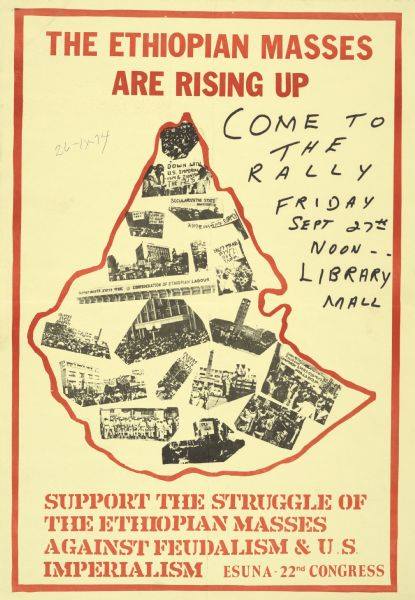
Despite instituting a number of very radical reforms, the military government, known as the Derg, kept a tight grip on the reins of power, and it established a reputation for dealing harshly with any opposition, including labor and peasant unrest; and the EPRP and the military government soon came to blows. By the end of 1976, a state of near civil war existed between the military and armed urban units of the EPRP and its rural guerrilla force the Ethiopian People’s Revolutionary Army. The Ethiopian government also faced separatist rebels in Eritrea, and later in Tigray and other provinces of the former empire.
In early 1977, Mengistu engineered a coup against moderate elements in the military, signed a treaty with the Soviet Union, and, with the assistance of Meison, began an extermination campaign against the EPRP, accusing it of being Anarchist, Trotskyite and sometimes Maoist; the EPRP responded by calling the military government “fascist.” Thousands of people were killed.
From mid-1977 through 1978, acting on requests from Soviet advisors to rid the country of Chinese and Maoist influence, Mengistu turned on Meison and eventually other left factions, killing many thousands more, especially student and youth activists. At the same time, an invasion by neighboring Somalia undercut the civilian left’s popularity through the military junta’s appeals to Ethiopian patriotism. Massive numbers of Cuban troops, as well as advisors from the Soviet Union, East Germany and South Yemen, reinforced the military regime, defeated the invasion, and strengthened the state security apparatus.
In the student diaspora, radical Ethiopian students continued to organize themselves in groups like the Ethiopian Student Union in North America (ESUNA), Ethiopian Student Union in Europe (ESUE), and the World Wide Federation of Ethiopian Students (WWFES). The factionalism at home was evident in these organizations, and especially by the later part of the 1970s, the student movement became closely involved with factions of the New Communist Movement.
By and large the civilian left was successfully eradicated by the Derg. Some individual members of various civilian left groups survived to found Mengistu’s largely military-based state communist party, the Workers Party of Ethiopia, in 1984. Mengistu was overthrown in 1991 by a coalition of military forces dominated by the Tigray People’s Liberation Front (TPLF), itself organized by a clandestine cadre called the Marxist-Leninist League of Tigray, which was allied with the Hoxhaist wing of the 1980s anti-revisionist movement. However today’s Ethiopian government, still dominated by the TPLF, is closely allied with U.S. imperialism.
EROL Note: We thank Ian Horst, whose vast knowledge, writings and documents made this page possible. We are looking for additional materials to supplement the documents included here. If you have other Ethiopian anti-revisionist materials and would be willing to share them with us, please contact us at: [email protected].
The Ethiopian Revolution 1974-1984 by Andargachew Tiruneh
To Kill A Generation: The Red Terror in Ethiopia by Babile Tola
Building Ethiopia's Revolutionary Party by Patrick Gilkes
Afro-Marxism: Formation of the Working Party of Ethiopia by Vlastimil Fiala
Addis Ababa University in the Shadow of the Derg, 1974-1991 by Randi Rønning Balsvik
The Ethiopian Student Movement (ESM): My Experiences in ESUNA, 1964-1971 by Alem Habtu
Class Struggle and the Problem in Eritrea
From Autocracy to Bourgeois Dictatorship by Addis Hiwet
Ethiopia and Socialist Theory: The Blood on the Wall by Ken Tarbuck
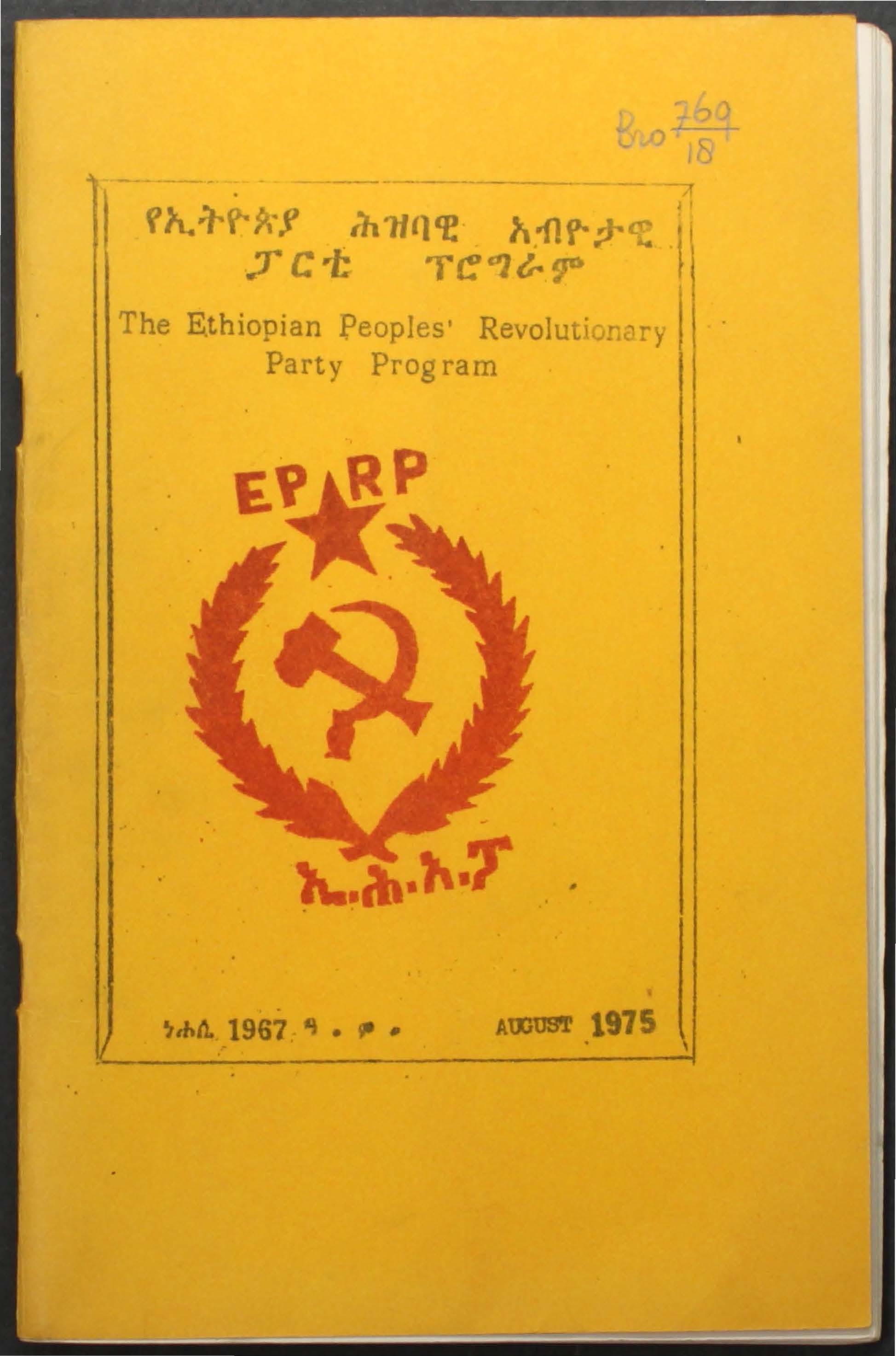
The Ethiopian Peoples’ Revolutionary Party was formally proclaimed in August of 1975, and was Ethiopia’s first political party. It supported the Ethiopian People’s Revolutionary Army, and mass organizations like the Ethiopian People’s Revolutionary Youth League, the Ethiopian Women’s Organization, the Revolutionary Workers Union of Ethiopia, and the Organization of Oppressed Soldiers. Its members and supporters were said to number in the tens of thousands.
The EPRP was created out of the merger of the Ethiopian People’s Liberation Organization and several other currents. EPLO was based in Algiers, but founded in West Berlin in 1972 by veteran and current radical student leaders in exile including Berhane Meskel Redda and Tesfaye Debessay. The other revolutionary groups inside Ethiopia it absorbed included the Abyot (“Revolution”) group led by Getachew Maru (called by some “the first Maoist in Ethiopia”), and Red Banner. Its main journal was Democracia (“Democracy”), which began publishing underground in 1974. Abyot became the name of the journal published by its foreign section in Europe from 1976 through the 1980s. The EPRP considered the military junta hijackers of the 1974 revolution, and soon became its adversaries. The Derg launched a campaign of lethal, violent repression against the EPRP in 1976, which was met by armed resistance including reprisal assassinations. In 1977 after consolidation of his regime and the establishment of an alliance with the Soviet Union, Mengistu declared all out war on EPRP and other leftist opponents, killing as many as several hundred thousand people by the time the government’s so-called “Red Terror” campaign ceased in 1978-1979.
The EPRP was formed as an explicitly Marxist-Leninist party, and declared as its goal a new democratic revolution on the path to socialism. It opposed US imperialism, supported (and received military training from) Palestinian revolutionaries, and supported self-determination up to and including independence for Ethiopia’s national minorities, including Eritrea. When the Derg allied itself to Cuba and the Soviet Union, the EPRP began to call the Soviet Union “social imperialist.” Politically, the EPRP enthusiastically advocated for the MPLA in Angola, but it also came to oppose the Vietnamese invasion of Kampuchea. The EPRP’s supporters in North American and Europe inside the diaspora Ethiopian student movement through the late 1970s tended to be much more closely linked with the New Communist Movement than the party at home was. Given the intense repression the EPRP experienced, its involvement in the international left’s debates tended to be guided by pragmatism and necessity, which meant ultimately a harsh analysis of the Soviet Union.
The majority of the EPRP’s original leaders were killed by the Derg during the so-called “Red Terror.” It retreated to guerrilla bases in rural northern and western Ethiopia, where it continued to combat the Derg. However, by the early 1980s it dropped Marxism-Leninism from its program, as well as its support for various national liberation movements, with whom it came to blows. The EPRP did not join the Ethiopian People’s Revolutionary Democratic Front which overthrew the Derg in 1991, and today remains banned by the government.
Petty Bourgeois Radicalism and Left Infantalism in Ethiopia: The Case of EPRP by Yabiyot Mestawot
The Ethiopian Peoples’ Revolutionary Party Program
Editorial: The War in the Ogaden Abyot, Vol. II, No. 5, July-August 1977
EPRP Internal Document on the Tigray People's Liberation Front
Abyot Information Bulletin of the Ethiopian Peoples’ Revolutionary Party (1976-1985)
Ethiopian Marxist Review, No. 1, August 1980
[Back to top]
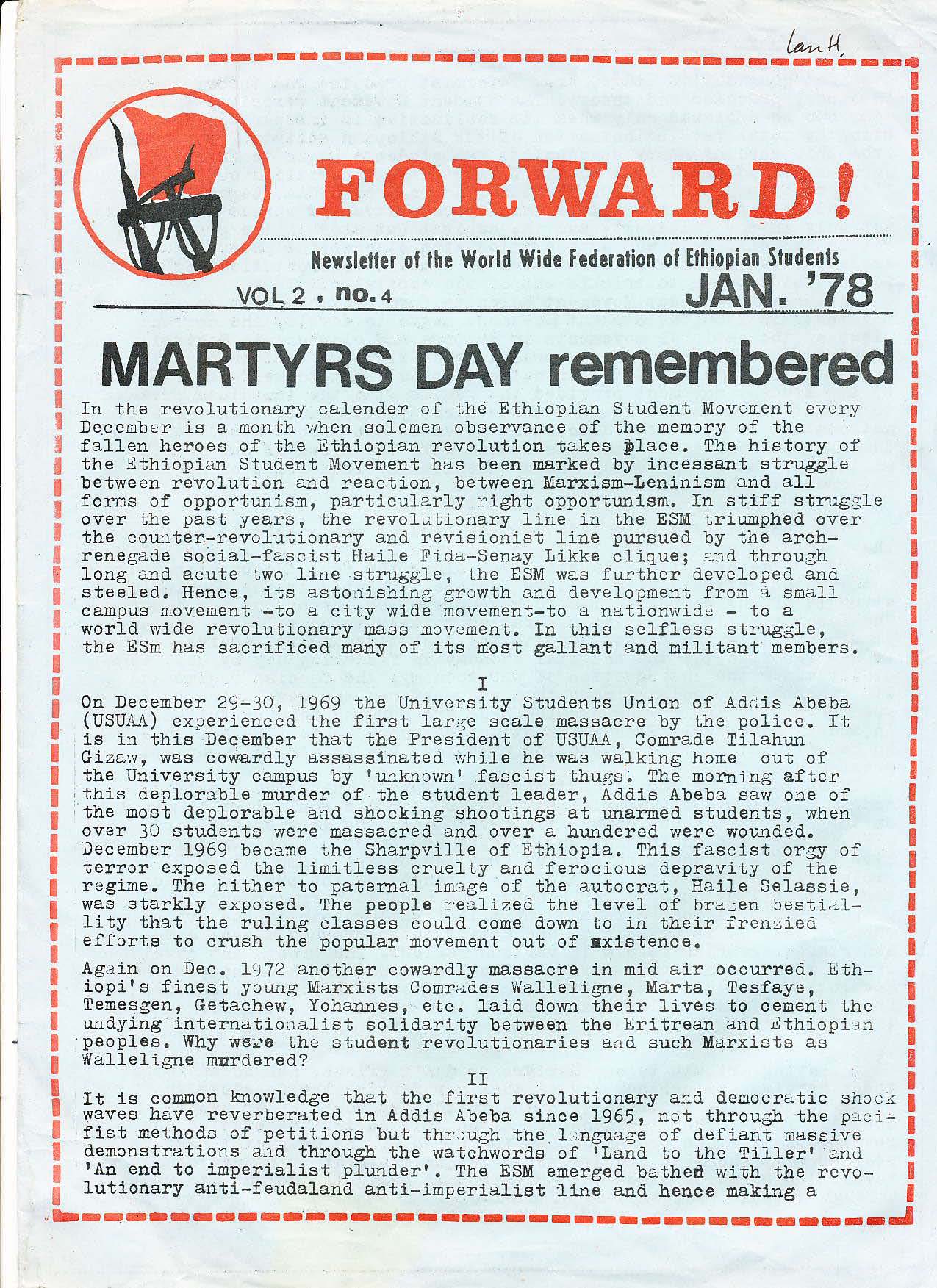
There were no political parties nor free press in Ethiopia in the late 1960s, but both the domestic and diaspora student movement largely came to be dominated by avowed Marxist-Leninists. Student publications became the vehicle for the debate and discussion of revolutionary ideas that was otherwise banned. A wave of repression by the imperial government drove many revolutionary students out of the country and drove others underground. The Ethiopian student movement abroad became a center of revolutionary debate, and a vehicle for international solidarity with revolutionaries at home after 1974.
The ideological fractures in the Ethiopian left were reflected in the student movement. Eritrean students broke away to form their own organizations, and different regional organizations aligned themselves with different political forces back home. The Ethiopian Students Union in North America (ESUNA, originally ESANA, the Ethiopian Students Association in North America), came under the domination of activists loyal to what would become the EPRP after a split in 1971. In the late 1970s, ESUNA initiated several discussions of Soviet social imperialism.
The World-Wide Federation of Ethiopian Students (WWFES) was likewise a virtual diaspora mass organization of the EPRP, while the Ethiopian Student Union in Europe (ESUE) came to be dominated by the initially pro-Derg All-Ethiopian Socialist Movement (Meison). Certain member unions in Europe, like that in the Netherlands, remained pro-EPRP.
All of these organizations seem to have faded away in the early 1980s.
On the Question of Nationalities in Ethiopia By Walleligne Mekonnen
Solidarity with Viet Nam [1968]
Bulletin of the World Wide Federation of Ethiopian Students Vol. 2, No. 1, October 1974
Statement on the New Wave of Fascistic Repression in Ethiopia November 10, 1976
Forward! Vol. 1, No. 3, January 1977
Forward! Vol. 1, No. 4, February 1977
Forward! Vol. 1, No. 5, March 1977
Forward! Vol. 1, No. 6-7, April-May 1977
Forward! Vol. 2, No. 4, January 1978
Zena Vol. 1, No. 4, May 1978
Challenge Vol. 5, No. 1, March 1965
Challenge Vol. VI, No. 1, August 1966
Challenge Vol. VII, No. 1, August 1968
The Liberation of the Imperial Ethiopian Government Embassy in Washington DC, July 1969
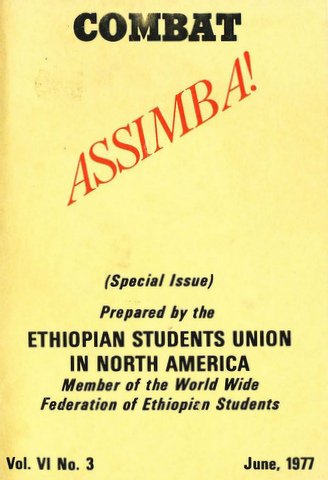
Ethiopian Students Hold 20th Congress [The Call, Vol. 1, No. 3, December 1972]
Statement on the Formation of the Ethiopian Peoples' Revolutionary Party
Handbook on Elementary Notes on Revolution and Organization
Report on the 23rd Congress of the Ethiopian Students Union of North America [Combat, Vol. 3, No. 2, August 1975]
Firmly Oppose and Denounce the Fascistic War of Extermination Against the Ethiopian People
Assimba! [Combat, Vol. VI, No. 3, June 1977]
Report on the 25th Congress of the Ethiopian Students Union of North America [Combat, Vol. VI, No. 5, August 1977]
Soviet Social-Imperialism and the Ethiopian Revolution
Firmly Oppose the Treacherous "Ethiopian-Soviet Treaty of Friendship and Cooperation"
The Heroic Struggle of the Ethiopian Peoples and Youth Against Feudalism and Imperialism by a member of the "Ethiopian Student Union in Europe" in West Germany
ESUE Letter to Amnesty International
The Heroic Struggle of the Ethipian Peoples and Youth Against Feudalism and Imperialism by an ESUE member in West Germany
[Back to top]
The All-Ethiopian Socialist Movement, usually referred to by its Amharic acronym Meison, was organized covertly by Ethiopian intellectuals living in Europe in 1968, most importantly by Haile Fida, a respected academic. Meison remained a secret organization until its leadership returned to Ethiopia in 1974, when they opened a bookshop distributing cheap Chinese Marxist-Leninist pamphlets, and began an underground paper called Ye Sefiw Hizb Dimts or “Voice of the Broad Masses.” But unlike the EPRP, Haile Fida chose to work with the Derg, and became one of its chief political advisors. Ironically, though Meison was highly influenced by the anti-revisionist movement, under Haile Fida’s mentorship the Derg moved closer and closer to the Soviet Union. Meison members became deeply embedded in the Derg’s own mass organizations and the state apparatus – especially the state security apparatus – and the initial wave of Derg repression against EPRP was largely directed by Meison, which made Meison a target for EPRP reprisals. But several months into 1977, Meison balked at increasing Soviet domination just as the Soviet Union began to demand the Derg rid the country of Chinese influences, and Meison went into opposition. The Derg’s “red terror” campaign was extended against Meison, whose leadership including Haile Fida was largely arrested and executed.
Meison’s mass organizations included ISEANE, the Ethiopian Women’s Revolutionary Movement and a youth organization. In the student diaspora, Meison dominated the Ethiopian Student Union in Europe, and established a small counterweight to ESUNA in the US called the United Progressive Ethiopian Students Union in North America (UPESUNA). Meison published a journal in Europe called “New Ethiopia.” In the early 1980s surviving Meison leaders issued a self-criticism of their 1970s practice. Meison remains in existence today.
Programme of the All Ethiopian Socialist Movement 1975
Programme du Mouvement Socialiste Panethiopien 1975
Petty Bourgeois Radicalism and Left Infantalism in Ethiopia: The Case of EPRP by Yabiyot Mestawot
Women in the Ethiopian Revolution
New Ethiopia, November-December 1980
[Back to top]
Senay Likke was a former chemical engineering student and martial arts master in Oakland, who not insignificantly, seems to have been mentored by Nelson Peery of the California Communist League and Communist Labor Party. He was the leader of ESUNA until a contentious split in 1971, waged largely over the national question; Senay opposed Eritrean independence. He returned to Ethiopia on the eve of the 1974 uprising, where he began to train members of the military in karate and Marxist-Leninist ideology. He formed the Waz League, which remained more or less clandestine and was known for its influence among a layer of the military, and preserved his ties with the CLP back in the United States. He began to work with the Derg more or less from its beginning, and along with Haile Fida of Meison, became a close supporter of military rule. Senay Likke himself was killed during the February 1977 coup, but Waz League continued on until 1978–1979. It was the last organization that came to be targeted by the “Red Terror,” and many of its members were purged and killed.
The Ethiopian Revolution (Tasks, Achievements, Problems and Prospects) by Senay Likke
[Back to top]
Emaledh was formed out of five pro-military government leftist organizations in mid-1977 as a step toward the formation of an official, governing communist party. The organizations included Meison; Waz League; Seded (“Revolutionary Flame,” a group sponsored by Mengistu and largely comprised of military cadre who had returned from training in the Soviet Union), and two smaller groups called Echaat and Malerid. Shortly after it formed, Meison dropped out. It published a journal in English and Amharic called Yehibret Demts, or “Voice of Unity.” By the time it was transformed into the Committee to Organize the Party of the Workers of Ethiopia (COPWE) in 1979, all the factions except Seded had been purged. COPWE established the Workers Party of Ethiopia in 1984, strongly modeled on the state communist parties of the Soviet bloc and led by military officers.
Action Programme of the Common Front of Ethiopian Marxist-Leninist Organizations
[Back to top]
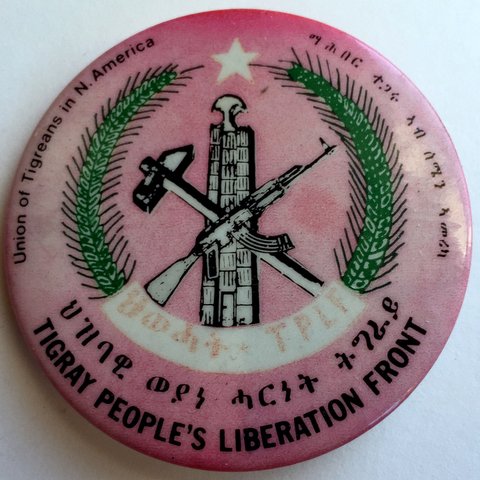
A Political History of the Tigray People’s Liberation Front (1975-1991): Revolt, Ideology and Mobilisation in Ethiopia by Aregawi Berhe
Post-War Narratives of Women Ex-Combatants of the Tigray People’s Liberation Front (TPLF) by Beza Negewo Oda
People's Democratic Programme of the Tigray People's Liberation Front
Some Stands of the Marxist-Leninist Core of the Tigray People's Liberation Front, T.P.L.F.
Eritrean People's Liberation Front and Tigray People's Liberation Front - Joint Statement
People's Voice, Vol. 12, Nos. 1-2, January-June 1990
[Back to top]